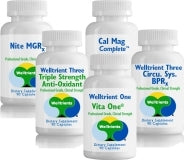
Frequently Asked Questions about Welltrient BPRx Pack- Five Bottle Set
Why Would You Use Welltrient BPRx Pack- Five Bottle Set
How Does Welltrient BPRx Pack- Five Bottle Set Work?
Directions for Use For Welltrient BPRx Pack- Five Bottle Set
Ingredients For Welltrient BPRx Pack- Five Bottle Set
About Colloids For Life
|
Colloids for Life LLC
Natural Supplements and Vitamins for Optimum Health
Colloids for Life LLC is dedicated to health and wellness, including offering top quality, natural supplements and encouraging a healthy lifestyle that includes good nutrition and exercise. For a variety of useful health tips as well as the latest health news, subscribe to our newsletter, sign up for our blog feed, like us on Facebook and/or follow us on Twitter.
Location Colloids for Life is located at: 7100 Broadway Bldg 2RS Denver CO 80221 |










